Prone-lying for 30 minutes twice a day prevents hip flexor tightness. While in the prone position, the person can also perform either or both active hip extension and thoracic extension exercises.
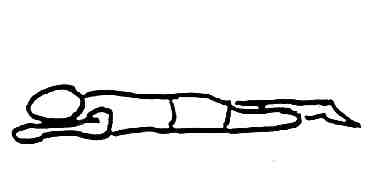
The person can use a rolled towel, or can pad a small stool or a phone book with a pillow, then perform a series of exercises that provide modified weight-bearing. For instance, the person can strengthen the hip extensors by "bridging," using the residual limb to lift the pelvis from the supporting surface. People with amputations should perform this exercise bilaterally.
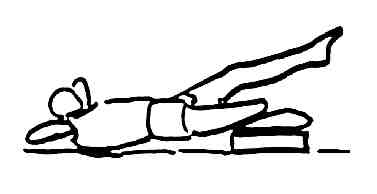
The person can strengthen the hip abductors by lying on the amputated limb, then "bridging" to lift the pelvis from the supporting surface. This rather strenuous exercise employs the gluteus medius, a muscle that is important for gait, in a range that is similar to that during stance phase. To avoid substitution by the tensor fascia lata, the person must neither flex the involved hip nor roll the pelvis backward. People with amputations should perform this exercise, like the hip extensor exercise, bilaterally.
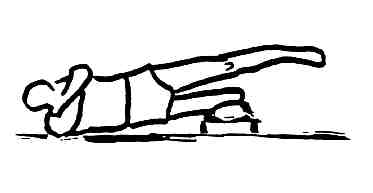
Patients with transfemoral amputations can strengthen the residual hip adductors by lying on the side opposite that of the amputation. The involved limb rests on the padded stool while the bottom (uninvolved) hip is flexed so that it rests comfortably in front of the stool. Strengthening of the residual adductor muscle group compensates for its decreased mass and the consequent risk of hip abductor tightness.
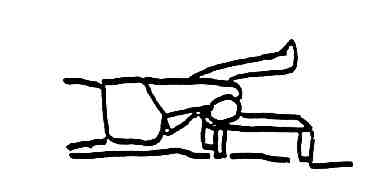
Partial sit-ups and other abdominal strengthening exercises are appropriate but may be difficult if the lower limbs' reduced weight cannot stabilize the pelvis. The patient should not wear the prosthesis for stabilization but should find other stabilization, including help from another person.
The amputee can perform conventional sit-ups, or alternatives like the exercise pictured here, in which a helper stabilizes the amputated limb while the person simultaneously flexes and rotates the trunk toward the amputated limb. The exercise requires abdominal activity in combination with hip flexion, adduction, and internal rotation. This hip muscle activity helps balance and prevent the abductor and external rotator tightness that is common among people with transfemoral amputations.
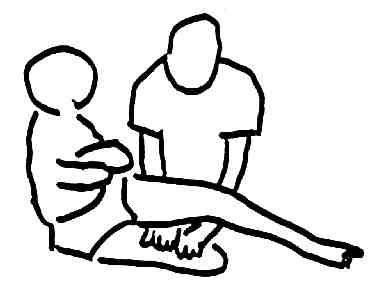

The person can use a rolled towel, or can pad a small stool or a phone book with a pillow, then perform a series of exercises that provide modified weight-bearing. For instance, the person can strengthen the hip extensors by "bridging," using the residual limb to lift the pelvis from the supporting surface. People with amputations should perform this exercise bilaterally.

The person can strengthen the hip abductors by lying on the amputated limb, then "bridging" to lift the pelvis from the supporting surface. This rather strenuous exercise employs the gluteus medius, a muscle that is important for gait, in a range that is similar to that during stance phase. To avoid substitution by the tensor fascia lata, the person must neither flex the involved hip nor roll the pelvis backward. People with amputations should perform this exercise, like the hip extensor exercise, bilaterally.

Patients with transfemoral amputations can strengthen the residual hip adductors by lying on the side opposite that of the amputation. The involved limb rests on the padded stool while the bottom (uninvolved) hip is flexed so that it rests comfortably in front of the stool. Strengthening of the residual adductor muscle group compensates for its decreased mass and the consequent risk of hip abductor tightness.

Partial sit-ups and other abdominal strengthening exercises are appropriate but may be difficult if the lower limbs' reduced weight cannot stabilize the pelvis. The patient should not wear the prosthesis for stabilization but should find other stabilization, including help from another person.
The amputee can perform conventional sit-ups, or alternatives like the exercise pictured here, in which a helper stabilizes the amputated limb while the person simultaneously flexes and rotates the trunk toward the amputated limb. The exercise requires abdominal activity in combination with hip flexion, adduction, and internal rotation. This hip muscle activity helps balance and prevent the abductor and external rotator tightness that is common among people with transfemoral amputations.


The person can strengthen the hip abductors by lying on the amputated limb, then "bridging" to lift the pelvis from the supporting surface. This rather strenuous exercise employs the gluteus medius, a muscle that is important for gait, in a range that is similar to that during stance phase. To avoid substitution by the tensor fascia lata, the person must neither flex the involved hip nor roll the pelvis backward. People with amputations should perform this exercise, like the hip extensor exercise, bilaterally.

Patients with transfemoral amputations can strengthen the residual hip adductors by lying on the side opposite that of the amputation. The involved limb rests on the padded stool while the bottom (uninvolved) hip is flexed so that it rests comfortably in front of the stool. Strengthening of the residual adductor muscle group compensates for its decreased mass and the consequent risk of hip abductor tightness.

Partial sit-ups and other abdominal strengthening exercises are appropriate but may be difficult if the lower limbs' reduced weight cannot stabilize the pelvis. The patient should not wear the prosthesis for stabilization but should find other stabilization, including help from another person.
The amputee can perform conventional sit-ups, or alternatives like the exercise pictured here, in which a helper stabilizes the amputated limb while the person simultaneously flexes and rotates the trunk toward the amputated limb. The exercise requires abdominal activity in combination with hip flexion, adduction, and internal rotation. This hip muscle activity helps balance and prevent the abductor and external rotator tightness that is common among people with transfemoral amputations.


Patients with transfemoral amputations can strengthen the residual hip adductors by lying on the side opposite that of the amputation. The involved limb rests on the padded stool while the bottom (uninvolved) hip is flexed so that it rests comfortably in front of the stool. Strengthening of the residual adductor muscle group compensates for its decreased mass and the consequent risk of hip abductor tightness.

Partial sit-ups and other abdominal strengthening exercises are appropriate but may be difficult if the lower limbs' reduced weight cannot stabilize the pelvis. The patient should not wear the prosthesis for stabilization but should find other stabilization, including help from another person.
The amputee can perform conventional sit-ups, or alternatives like the exercise pictured here, in which a helper stabilizes the amputated limb while the person simultaneously flexes and rotates the trunk toward the amputated limb. The exercise requires abdominal activity in combination with hip flexion, adduction, and internal rotation. This hip muscle activity helps balance and prevent the abductor and external rotator tightness that is common among people with transfemoral amputations.


Partial sit-ups and other abdominal strengthening exercises are appropriate but may be difficult if the lower limbs' reduced weight cannot stabilize the pelvis. The patient should not wear the prosthesis for stabilization but should find other stabilization, including help from another person.
The amputee can perform conventional sit-ups, or alternatives like the exercise pictured here, in which a helper stabilizes the amputated limb while the person simultaneously flexes and rotates the trunk toward the amputated limb. The exercise requires abdominal activity in combination with hip flexion, adduction, and internal rotation. This hip muscle activity helps balance and prevent the abductor and external rotator tightness that is common among people with transfemoral amputations.
